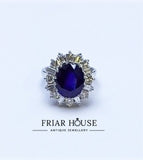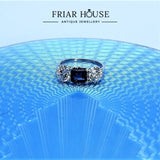With sapphire being the birthstone of September we felt it an ideal time to look deeper into the history of this gemstone.

It has been said that the tablet inscribed with the ten commandments was formed using a sapphire stone. Because of its hardness it would not be able to be broken even with the use of a hammer.
A member of the Beryl family, it rates 9 on the Mohs scale of hardness with ruby being the same. A diamond at 10 is many times harder and only a diamond can scratch a diamond. Corundum (sapphire or ruby) can scratch itself, topaz (8), quartz (7), and anything softer.
It is typically blue in colour but natural “fancy” sapphires also occur in yellow, purple, orange and green. The rarest type of sapphire is a pinkish orange variety called padparadscha, a name that comes from the Sanskrit word for lotus flower.
The star sapphire gets its name due to their special feature called asterism. It is caused by small needle like inclusions of the mineral rutile. This optical phenomenon occurs in almost all colours of sapphire.

For centuries, sapphire rings have been associated with royalty and romance. In 1981 Prince Charles gave a blue sapphire engagement ring to Lady Diana Spencer. This ring consisted of a 12 carat oval blue sapphire, cut into facets, and surrounded by fourteen solitaire diamonds. This has now been passed down from their son, Prince William to his now wife, Catherine, the Duchess of Cambridge.
It is known as the stone of destiny and is said to have many healing powers associated with it. Considered to be the gem of gems it is steeped in history and belief of nearly every religion. With truth, loyalty and devotion being associated with this stone it makes it a symbol of commitment to God.

Why not celebrate this month’s beautiful stone by treating yourself or your loved one to a sapphire ring?





